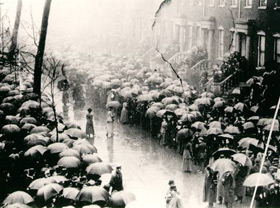DIRGE
Part Two, Chapter Thirteen (excerpt), page 151
If the day [of the funeral] had been filled with sunshine, the Tribune continued, "there would have been the chance to minimize the intensity of feeling existing among the marching members of the more than 60 sympathizing unions. Only a high devotion and sense of duty could be responsible for this protest.
"Low hanging clouds and fog shrouded the tops of buildings. The Metropolitan tower was invisible above its clock. There was the suggestion of smoke in the atmosphere. The streets were filled with puddles of water. Women in lamb's wool coats, accustomed to ride in automobiles, were splashed by passing vehicles as they trudged along in the beating rain. Hundreds of thousands stood on the sidewalks, their umbrellas appropriately indicating an unbroken border of black. Policemen, mounted and afoot, wore regulation black raincoats."
The World noted that "the street mud oozed through their thin shoes; they marched on silent, uncomplaining." The Tribune added that "here and there an older woman would insist upon taking a thinly clad young girl under her umbrella, or, if clad in a wool coat, under her wing."
The two contingents moved toward each other for the joining at Washington Square. The uptown division reached the park at two o'clock. For the next hour, it waited in the rain for the arrival of the downtown division. Shortly after three o'clock, the empty hearse heading that section came into view as it moved up MacDougal Street to the southwest corner of the Square. The two divisions of the city's massed workers were now facing diagonally across the park.
Washington Place, from the Square to Mercer Street, was one solid gathering of people. When word spread that the two sections of the parade had arrived, the crowd somehow managed to open a narrow lane down the middle of the street, expecting the parade to file past the Asch building.
But Inspectors Schmittberger and Sweeney had misgivings. They feared an outburst of mass hysteria and after a short conference altered the route of the procession so that the downtown divisions, instead of joining the other for a march through Washington Place would meet it at Fifth Avenue and proceed uptown.
The change had been made because, as the American reported, "it was not until the marchers reached Washington Square and came in sight of the Asch building that the women gave vent to their sorrow.
"It was one long-drawn-out, heart-piercing cry,the mingling of thousands of voices, a sort of human thunder in the elemental storm--a cry that was perhaps the most impressive expression of human grief ever heard in this city."
Leon Stein, The Triangle Fire (New York: A Carroll & Graf/Quicksilver Book, 1962), pp. 151-152.
The Kheel Center would like to thank Mrs. Miriam Stein and Barbara Ismail for granting permission to use selections from the late Leon Stein's book.

